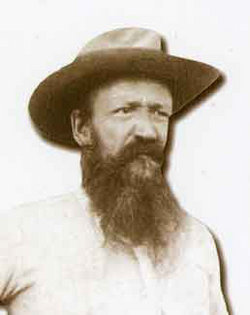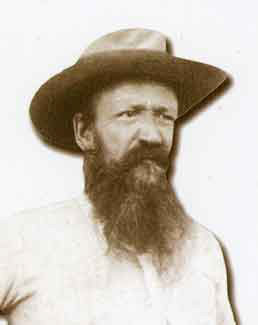From Wikipedia, the free encyclopedia
Axel Wilhelm Eriksson (1846–1901) was a Swedish ornithologist, settler and trader in what is now Namibia. He was born in Vänersborg, in Sweden.Eriksson went to South-West Africa in 1866 (before Germany had established its colony of German South West Africa in 1884) to serve out a three-year apprenticeship to Charles John Andersson. In 1871, with Swede Anders Ohlsson, he established a brewery at Omaruru. Eriksson established a trading post there, which flourished and by 1878 employed about forty whites.[1] Eriksson's business was based upon long-distance trading between southern Angola and Cape Colony, which necessitated the establishment of regional trade routes[2]. He also built up an extensive bird collection, specimens coming from South West Africa, Angola and the Transvaal (now Gauteng Province in South Africa), which has since been donated to the municipal museum in Vänersborg.[3] His activities gained much respect from a wide range of communities, including native and Boer, over a large geographic area. He was known to the Herero as Karuwapa Katiti ("the small white person").[3] Axel Eriksson died on May 5, 1901 at Urupupa[4]. It was said that "when Karuwapa died, the goodness in the country died as well". His grave at Rietfontein, thirty kilometres south west of Grootfontein, was made a national monument in 1978; a sign beside the grave reads: "This is the last resting place of Axel Eriksson, well known traveller, hunter, trader and pioneer, through whose intercession the Cape Government sent food to the distressed thirstland trekkers in 1879 thus rescuing various families from certain death".[3] Eriksson married Fanny Stewardson, in 1871 and the couple had two sons, Axel Eriksson (1871-1924 (died at Gaideb, Warmbad)), a noted painter[5] and Andrew Albert Eriksson (1876-), who became a priest in Sweden. There was also a daughter, Maud Alice Eriksson. Eriksson's two brothers, Carl and Gustav also migrated to South-West Africa.[6]
References
1. Christison, G. "BEYOND THE PALE: DAMARALAND & OVAMBOLAND".
2. Sellström, Tor (1999). "Sweden and National Liberation in Southern Africa: Volume 1". Nordiska Afrikainstitutet, Uppsala. "The Trader King of Damaraland Axel Eriksson; A Swedish Pioneer in Southern Africa". Namibiana. 2004. Dierks, Klaus (January 2005). "1901". CHRONOLOGY OF NAMIBIAN HISTORY, From Pre-historical Times to Independent Namibia.
3."Landscape and Wildlife Artists".
4. Dierks, Klaus (2003-2004). "BIOGRAPHIES OF NAMIBIAN PERSONALITIES" AXEL WILLIAM ERIKSSON OF HEREROLAND (1846-1901): His Life and Letters. NAMIBIA: GAMSBERG MACMILLAN. 2006. 9991607463.
5 Johansson, Peter (2007). THE TRADER KING OF DAMARALAND: Axel Eriksson - A Swedish Pioneer in Southern Africa. NAMIBIA: GAMSBERG MACMILLAN. 9789991608518.
External links
Vänersborg Museum,Vänersborg,Sweden
Axel owned a farm named Aukas (N0775) north of Grootfontein which he stayed on for a time in March 1868, he later bought the farm and it became his headquarters from 1895 to his death in 1901
From Wikipedia, the free encyclopedia
Axel Wilhelm Eriksson (1846–1901) was a Swedish ornithologist, settler and trader in what is now Namibia. He was born in Vänersborg, in Sweden.Eriksson went to South-West Africa in 1866 (before Germany had established its colony of German South West Africa in 1884) to serve out a three-year apprenticeship to Charles John Andersson. In 1871, with Swede Anders Ohlsson, he established a brewery at Omaruru. Eriksson established a trading post there, which flourished and by 1878 employed about forty whites.[1] Eriksson's business was based upon long-distance trading between southern Angola and Cape Colony, which necessitated the establishment of regional trade routes[2]. He also built up an extensive bird collection, specimens coming from South West Africa, Angola and the Transvaal (now Gauteng Province in South Africa), which has since been donated to the municipal museum in Vänersborg.[3] His activities gained much respect from a wide range of communities, including native and Boer, over a large geographic area. He was known to the Herero as Karuwapa Katiti ("the small white person").[3] Axel Eriksson died on May 5, 1901 at Urupupa[4]. It was said that "when Karuwapa died, the goodness in the country died as well". His grave at Rietfontein, thirty kilometres south west of Grootfontein, was made a national monument in 1978; a sign beside the grave reads: "This is the last resting place of Axel Eriksson, well known traveller, hunter, trader and pioneer, through whose intercession the Cape Government sent food to the distressed thirstland trekkers in 1879 thus rescuing various families from certain death".[3] Eriksson married Fanny Stewardson, in 1871 and the couple had two sons, Axel Eriksson (1871-1924 (died at Gaideb, Warmbad)), a noted painter[5] and Andrew Albert Eriksson (1876-), who became a priest in Sweden. There was also a daughter, Maud Alice Eriksson. Eriksson's two brothers, Carl and Gustav also migrated to South-West Africa.[6]
References
1. Christison, G. "BEYOND THE PALE: DAMARALAND & OVAMBOLAND".
2. Sellström, Tor (1999). "Sweden and National Liberation in Southern Africa: Volume 1". Nordiska Afrikainstitutet, Uppsala. "The Trader King of Damaraland Axel Eriksson; A Swedish Pioneer in Southern Africa". Namibiana. 2004. Dierks, Klaus (January 2005). "1901". CHRONOLOGY OF NAMIBIAN HISTORY, From Pre-historical Times to Independent Namibia.
3."Landscape and Wildlife Artists".
4. Dierks, Klaus (2003-2004). "BIOGRAPHIES OF NAMIBIAN PERSONALITIES" AXEL WILLIAM ERIKSSON OF HEREROLAND (1846-1901): His Life and Letters. NAMIBIA: GAMSBERG MACMILLAN. 2006. 9991607463.
5 Johansson, Peter (2007). THE TRADER KING OF DAMARALAND: Axel Eriksson - A Swedish Pioneer in Southern Africa. NAMIBIA: GAMSBERG MACMILLAN. 9789991608518.
External links
Vänersborg Museum,Vänersborg,Sweden
Axel owned a farm named Aukas (N0775) north of Grootfontein which he stayed on for a time in March 1868, he later bought the farm and it became his headquarters from 1895 to his death in 1901
Gravesite Details
The farm is called Urupupa near Gootfontien
Family Members
Sponsored by Ancestry
Advertisement
Explore more
Sponsored by Ancestry
Advertisement




